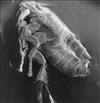| Fleas | Fleas | Fleas are “nest parasites”. They generally move between the host animal (cat or dog) and the bedding (nest). The typical flea population in a home is comprised of 50% eggs, 35% larvae, 10% pupae, and only 5% adult fleas. Eggs, larvae and pupae are typically found in pet bedding, carpets, rugs, or on upholstered furniture where pets sleep. Since adult fleas are not good climbers, they are mainly found on host animals, on the floor or in bedding materials. Eggs are loosely attached to the host and can be jarred loose onto carpets when the host jumps or scratches. The small, whitish, worm-like flea larvae feed on adult fecal material which is composed of undigested blood. The fecal material looks like small, dark specks or grains of fine sand in the animal’s fur and is often the most easily noticed sign of an infestation. Fleas can last as pupae for several months in unoccupied homes or apartments, resulting in massive outbreaks on new inhabitants. This “outbreak” is triggered by pressure and vibration from footsteps, which stimulates the dormant fleas to literally jump out of their pupal cases and seek out the nearest host for a blood meal. In uninhabited homes or apartments with a flea infestation, the population is composed almost entirely of juvenile fleas (mainly pupae), so controls aimed only at adults will not effectively eliminate an infestation in empty dwellings. In our area, fleas in lawns are not usually a significant problem due to environmental conditions, so outdoor chemical flea control is not necessary. |

|
